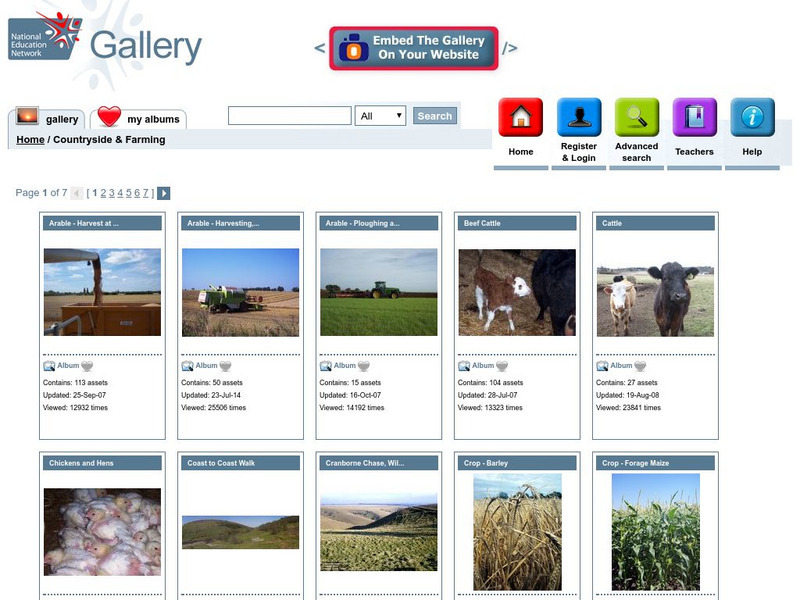Hi, what do you want to do?
CK-12 Foundation
Ck 12: Earth Science: Sedimentary Rock Classification
[Free Registration/Login may be required to access all resource tools.] Explains that sedimentary rocks are classified by how they formed and by grain size.
Other
E2 Bn Gallery: Countryside & Farming Photographs
This British site has wonderful collections of agricultural photographs typical of farms in developed countries. Many of them were submitted by teachers. Students can see machinery used in farming, how grain is ground, the types of...
University of Michigan
Univerisity of Michigan: A Taste of the Ancient World: Farming at Karanis
See pictures of tools used in grain production in ancient Egypt. The artifacts are similar to tools used today.
Khan Academy
Khan Academy: The Tomb Chapel of Nebamun
The British Museum contains 11 fragments of wall painting, some of the most famous images of Egyptian art. The fragments come from the now lost tomb-chapel of Nebamun, an ancient Egyptian scribe or, "scribe and grain accountant in the...
PBS
Pbs: The Lowdown: Rot and Rubbish: The Rancid Truth About How Much Food We Waste
Explore the math of worldwide food waste, with focus on percentage, in this infographic from KQED. In the accompanying classroom activity, students predict the percent of food in each of the various categories (e.g., grains, fruit, etc.)...
Countries and Their Cultures
Countries and Their Cultures: Hazara
Most Hazara live in central Afghanistan in an area known as the Hazarajat. Others live in areas north of the Hindu Kush. The Hazarajat and other Hazara territories are mountainous. The climate is severe in winter, with heavy snowfall;...
Countries and Their Cultures
Countries and Their Cultures: Hausa
The Hausa constitute the largest ethnic group in West Africa. The term "Hausa" actually refers to the language and, by extension, to its native speakers, of whom there are about 25 million. Agriculture is the main economic activity....
Countries and Their Cultures
Countries and Their Cultures: Karamojong
The Karamojong are a pastoral group who inhabit the plateau region of Uganda. Linguistically, the Karamojong belong to the Central Group of the Nilote Language Family, which also includes several neighboring groups that speak a mutually...
Countries and Their Cultures
Countries and Their Cultures: Bedouin
Bedouin societies are found in the arid steppe regions of Arabia and North Africa and along the margins of rain-fed cultivation. Bedouin groups move their animals to areas where pasture is regularly found. Often these societies plant...
Countries and Their Cultures
Countries and Their Cultures: Anuak
The Anuak live in a region straddling the border of the southern Sudan and Ethiopia. The Anuak language is most closely related to Shilluk. Together, the two languages comprise a subfamily within the larger classification of Nilotic....
Unite for Literacy
Unite for Literacy: Plants and Food: Bread for Everyone
Learn about the different kinds of breads people eat around the world. Includes audio narration.
University of Illinois
University of Illinois Extension: Food for Thought: Bread, Cereal, Rice, and Pasta
In addition to explaining the nutritional value of foods in the "Bread, cereal, rice, and pasta," group, this website includes information on serving size and book resources on foods in the bread group. Also included is a recipe for...
Biology Pages
Kimball's Biology Pages: Sexual Reproduction in Angiosperms (Flowering Plants)
This site, from retired Harvard professor John W. Kimball, provides a detailed but understandable explanation of sexual reproduction in flowering plants. Includes informative, well labelled illustrations.
National Academies of Sciences, Engineering, and Medicine
The National Academies: Emerging Technologies: Biofuels
Biofuels are made from organic materials such as corn and algae, as well as sugars and starches from plant cellulose. They have advantages such as sustainability and lowered greenhouse gas production, but they can impact on the...
University of Nebraska
University of Nebraska State Museum: Pollen Detective: About Pollen
Twelve different species of plant pollen are highlighted in this engaging resource. For each plant you can view pollen as seen under two different kinds of microscopes. Reproductive cycles and physical traits used for identification are...
University of Michigan
Univerisity of Michigan: A Taste of the Ancient World: Pharonic Egypt
Pictures of artifacts showing the importance of food and food offerings in Egyptian tombs. Provision for the afterlife was paramount.
Other popular searches
- Whole Grains
- Bread and Grains
- Cereal Grains
- Food Pyramid Grains
- Difference Between Grains
- Plant Products Grains
- Breakfast Cereal Grains
- Sand Grains
- Foods Meat and Grains
- Igneous Rock Grains
- What Are Grains
- Cooking Grains













